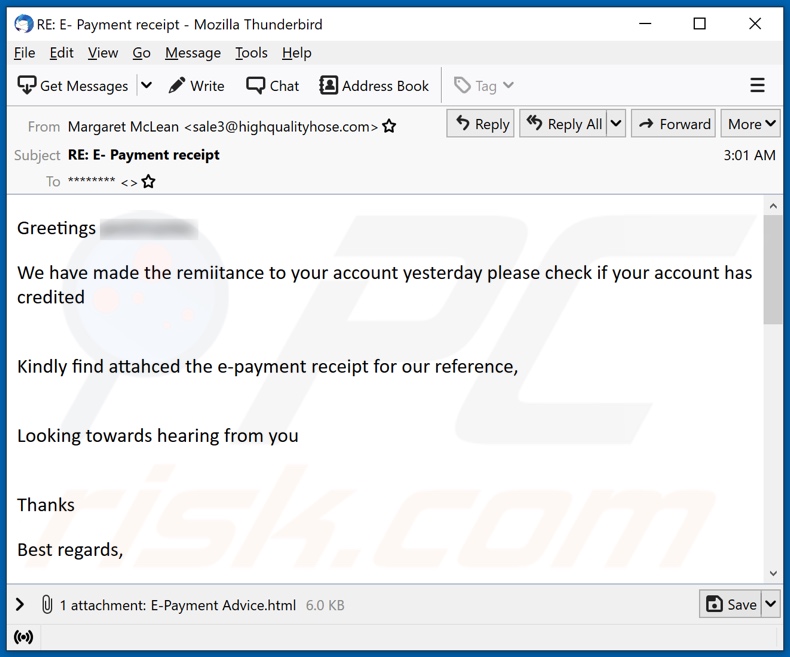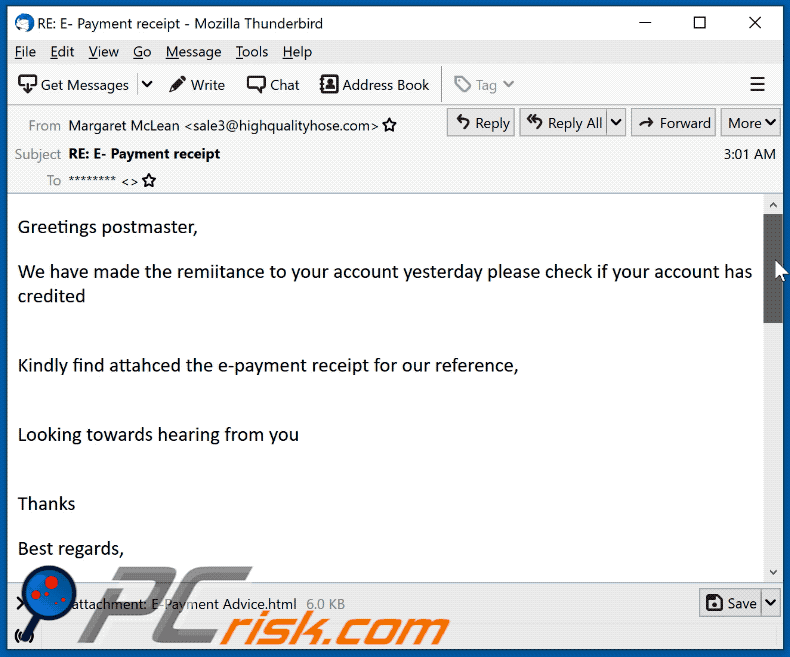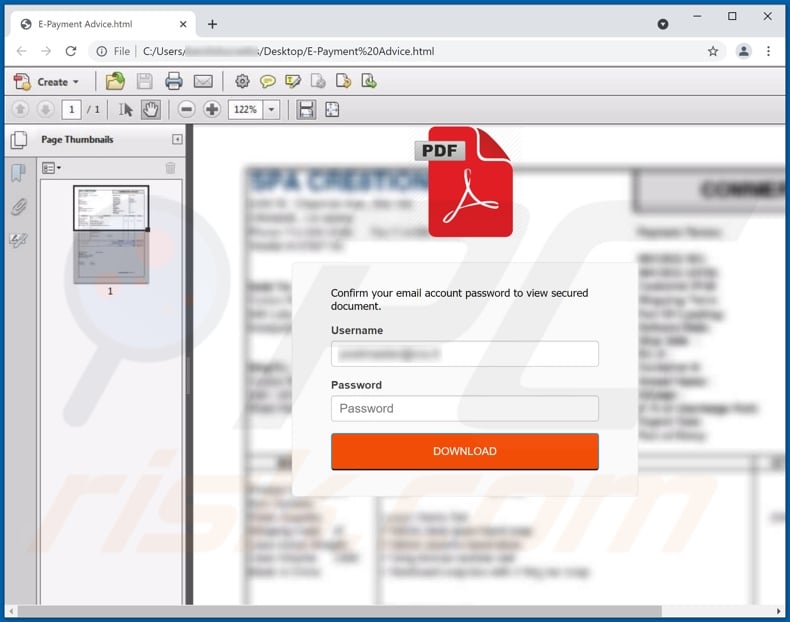Avoid getting scammed by fake "Gas Sensing Solutions (GSS)" emails
Phishing/ScamAlso Known As: Gas Sensing Solutions (GSS) spam
Get free scan and check if your device is infected.
Remove it nowTo use full-featured product, you have to purchase a license for Combo Cleaner. Seven days free trial available. Combo Cleaner is owned and operated by RCS LT, the parent company of PCRisk.com.
What is "Gas Sensing Solutions (GSS) email scam"?
"Gas Sensing Solutions (GSS) email scam" refers to a spam campaign. The deceptive emails sent through this campaign are disguised as letters from Gas Sensing Solutions (GSS) - a legitimate company. These emails are in no way associated with this company. The goal of the campaign is to promote a phishing file targeting email account log-in credentials.

"Gas Sensing Solutions (GSS) email scam" in detail
The scam emails request recipients to verify whether they have received a payment made to them. The letters claim to contain an "e-payment receipt" for reference. This deceptive file requires users to sign in using their email account credentials (passwords). Therefore, by attempting to view it - users will inadvertently expose their email accounts.
Emails are targeted due to being associated with other accounts. Hence, through hijacked mails - control may be gained over connected content. Scammers can use stolen communication platforms (e.g., emails, social media, etc.) to ask for loans or to proliferate malware under the guise of the real owner. Finance-related accounts (e.g., online banking, e-commerce, etc.) can be used to make fraudulent transactions and/or online purchases.
To summarize, by trusting these scam letters, users can experience severe privacy issues, financial losses, and identity theft. If attempts to access the phishing file have already been made, it is advised to immediately change the log-in credentials and contact the official support of all potentially compromised accounts.
| Name | Gas Sensing Solutions (GSS) email scam |
| Threat Type | Phishing, Scam, Social Engineering, Fraud |
| Fake Claim | Emails claim to contain an e-payment receipt. |
| Disguise | Emails are disguised as letters from Gas Sensing Solutions (GSS). |
| Attachment(s) | E-Payment Advice.html (filename may vary) |
| Detection Names (E-Payment Advice.html) | Cyren (URL/Phish.CJ.gen!Eldorado), Fortinet (HTML/Phish.5D60!tr), Ikarus (Phishing.HTML.Doc), Microsoft (Trojan:HTML/Phish.PAJ!MTB), Full List Of Detections (VirusTotal) |
| Symptoms | Unauthorized online purchases, changed online account passwords, identity theft, illegal access of the computer. |
| Distribution methods | Deceptive emails, rogue online pop-up ads, search engine poisoning techniques, misspelled domains. |
| Damage | Loss of sensitive private information, monetary loss, identity theft. |
| Malware Removal (Windows) |
To eliminate possible malware infections, scan your computer with legitimate antivirus software. Our security researchers recommend using Combo Cleaner. Download Combo CleanerTo use full-featured product, you have to purchase a license for Combo Cleaner. 7 days free trial available. Combo Cleaner is owned and operated by RCS LT, the parent company of PCRisk.com. |
Spam campaigns in general
"Storage Server Failure", "DHL Express Shipment Confirmation email scam", "We noticed a login from a device you don't usually use" - are a couple examples of phishing spam campaigns. Deceptive emails are used not only for various scams but also employed to distribute malware. Due to how widespread spam mail is, it is highly recommended to exercise caution with incoming emails.
How do spam campaigns infect computers?
Spam campaigns proliferate malware via infectious files distributed through them. The files can be attached to or linked inside the scam emails. Malicious files can be in various formats, e.g., archives, executables, PDF and Microsoft Office documents, JavaScript, etc. Upon opening, these files initiate malware download/installation.
For example, Microsoft Office documents infect systems by executing malicious macro commands. This process begins the moment a document is opened in Microsoft Office released prior to 2010. Newer versions have "Protected View" mode that prevents automatic execution of macros. Instead, users can manually enable macro commands (i.e., editing/content).
How to avoid installation of malware?
Suspicious and irrelevant emails must not be opened, especially any attachments or links found in them. It is also recommended to use Microsoft Office versions released after 2010.
Aside from spam mail, malware is spread via dubious download channels (e.g., unofficial and freeware websites, Peer-to-Peer sharing networks, etc.), illegal activation ("cracking") tools, and fake updates. It is advised to always download from official/verified sources and activate/update products with tools provided by genuine developers.
It is crucial to have a dependable anti-virus installed and kept updated. This software has to be used to run regular system scans and to remove threats. If you've already opened malicious attachments, we recommend running a scan with Combo Cleaner Antivirus for Windows to automatically eliminate infiltrated malware.
Text presented in the "Gas Sensing Solutions (GSS)" scam email letter:
Subject: RE: E- Payment receipt
Greetings ********,
We have made the remiitance to your account yesterday please check if your account has credited
Kindly find attahced the e-payment receipt for our reference,
Looking towards hearing from you
Thanks
Best regards,
Margaret McLean
Account department
Gas Sensing Solutions (GSS) Ltd
60-62 Grayshill Rd, Cumbernauld, UK, G68 9HQ
+44 (0)1236 781 900
| buehler@el-grosshandel.ch+44 (0)1236 781 900
Disclaimer Notice
This e mail and any files transmitted with it is confidential and is
intended only for the use of the recipient(s) named above. If you are not
the intended recipient, any review, retransmission, dissemination,
distribution, printing, copying or use the information contained in this
message or any part thereof in other manner is strictly prohibited. If you
received this e mail in error, please notify the sender immediately by
return e mail and delete the e mail and any of its attachment. Any personal
view or opinion expressed by the sender shall b e understood as neither
given nor endorsed by MJ or any of the companies within the Group.
Appearance of the "Gas Sensing Solutions (GSS)" scam email (GIF):

Screenshot of the phishing file distributed through the "Gas Sensing Solutions (GSS)" spam campaign ("E-Payment Advice.html"):

Instant automatic malware removal:
Manual threat removal might be a lengthy and complicated process that requires advanced IT skills. Combo Cleaner is a professional automatic malware removal tool that is recommended to get rid of malware. Download it by clicking the button below:
DOWNLOAD Combo CleanerBy downloading any software listed on this website you agree to our Privacy Policy and Terms of Use. To use full-featured product, you have to purchase a license for Combo Cleaner. 7 days free trial available. Combo Cleaner is owned and operated by RCS LT, the parent company of PCRisk.com.
Quick menu:
- What is Gas Sensing Solutions (GSS) spam?
- Types of malicious emails.
- How to spot a malicious email?
- What to do if you fell for an email scam?
Types of malicious emails:
![]() Phishing Emails
Phishing Emails
Most commonly, cybercriminals use deceptive emails to trick Internet users into giving away their sensitive private information, for example, login information for various online services, email accounts, or online banking information.
Such attacks are called phishing. In a phishing attack, cybercriminals usually send an email message with some popular service logo (for example, Microsoft, DHL, Amazon, Netflix), create urgency (wrong shipping address, expired password, etc.), and place a link which they hope their potential victims will click on.
After clicking the link presented in such email message, victims are redirected to a fake website that looks identical or extremely similar to the original one. Victims are then asked to enter their password, credit card details, or some other information that gets stolen by cybercriminals.
![]() Emails with Malicious Attachments
Emails with Malicious Attachments
Another popular attack vector is email spam with malicious attachments that infect users' computers with malware. Malicious attachments usually carry trojans that are capable of stealing passwords, banking information, and other sensitive information.
In such attacks, cybercriminals' main goal is to trick their potential victims into opening an infected email attachment. To achieve this goal, email messages usually talk about recently received invoices, faxes, or voice messages.
If a potential victim falls for the lure and opens the attachment, their computers get infected, and cybercriminals can collect a lot of sensitive information.
While it's a more complicated method to steal personal information (spam filters and antivirus programs usually detect such attempts), if successful, cybercriminals can get a much wider array of data and can collect information for a long period of time.
![]() Sextortion Emails
Sextortion Emails
This is a type of phishing. In this case, users receive an email claiming that a cybercriminal could access the webcam of the potential victim and has a video recording of one's masturbation.
To get rid of the video, victims are asked to pay a ransom (usually using Bitcoin or another cryptocurrency). Nevertheless, all of these claims are false - users who receive such emails should ignore and delete them.
How to spot a malicious email?
While cyber criminals try to make their lure emails look trustworthy, here are some things that you should look for when trying to spot a phishing email:
- Check the sender's ("from") email address: Hover your mouse over the "from" address and check if it's legitimate. For example, if you received an email from Microsoft, be sure to check if the email address is @microsoft.com and not something suspicious like @m1crosoft.com, @microsfot.com, @account-security-noreply.com, etc.
- Check for generic greetings: If the greeting in the email is "Dear user", "Dear @youremail.com", "Dear valued customer", this should raise suspiciousness. Most commonly, companies call you by your name. Lack of this information could signal a phishing attempt.
- Check the links in the email: Hover your mouse over the link presented in the email, if the link that appears seems suspicious, don't click it. For example, if you received an email from Microsoft and the link in the email shows that it will go to firebasestorage.googleapis.com/v0... you shouldn't trust it. It's best not to click any links in the emails but to visit the company website that sent you the email in the first place.
- Don't blindly trust email attachments: Most commonly, legitimate companies will ask you to log in to their website and to view any documents there; if you received an email with an attachment, it's a good idea to scan it with an antivirus application. Infected email attachments are a common attack vector used by cybercriminals.
To minimise the risk of opening phishing and malicious emails we recommend using Combo Cleaner Antivirus for Windows.
Example of a spam email:

What to do if you fell for an email scam?
- If you clicked on a link in a phishing email and entered your password - be sure to change your password as soon as possible. Usually, cybercriminals collect stolen credentials and then sell them to other groups that use them for malicious purposes. If you change your password in a timely manner, there's a chance that criminals won't have enough time to do any damage.
- If you entered your credit card information - contact your bank as soon as possible and explain the situation. There's a good chance that you will need to cancel your compromised credit card and get a new one.
- If you see any signs of identity theft - you should immediately contact the Federal Trade Commission. This institution will collect information about your situation and create a personal recovery plan.
- If you opened a malicious attachment - your computer is probably infected, you should scan it with a reputable antivirus application. For this purpose, we recommend using Combo Cleaner Antivirus for Windows.
- Help other Internet users - report phishing emails to Anti-Phishing Working Group, FBI’s Internet Crime Complaint Center, National Fraud Information Center and U.S. Department of Justice.
Share:

Tomas Meskauskas
Expert security researcher, professional malware analyst
I am passionate about computer security and technology. I have an experience of over 10 years working in various companies related to computer technical issue solving and Internet security. I have been working as an author and editor for pcrisk.com since 2010. Follow me on Twitter and LinkedIn to stay informed about the latest online security threats.
PCrisk security portal is brought by a company RCS LT.
Joined forces of security researchers help educate computer users about the latest online security threats. More information about the company RCS LT.
Our malware removal guides are free. However, if you want to support us you can send us a donation.
DonatePCrisk security portal is brought by a company RCS LT.
Joined forces of security researchers help educate computer users about the latest online security threats. More information about the company RCS LT.
Our malware removal guides are free. However, if you want to support us you can send us a donation.
Donate
▼ Show Discussion